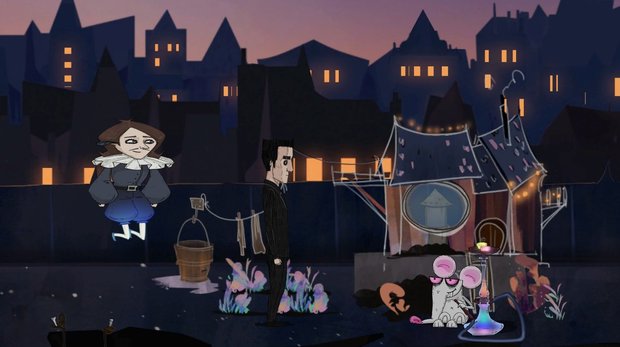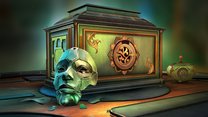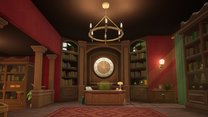Whateverland review

- 0 Comments
Flawed but fun dark comic adventure won’t leave you feeling indifferent
If Tim Burton, Vincent Price and Edgar Allan Poe ever decided to make a video game together, I wonder if it would look something like Whateverland. With its dark humour, gothy art style and gloomy setting, it wouldn’t surprise me if Caligari Games were inspired by more than one of these masters of the macabre when making their game. Whateverland is a fun and entertaining point-and-click adventure, with its outstanding puzzles and a delightful cast of characters, although I suspect it would have been less buggy and better voice-acted had one of these giants put their name on the end product.
You are thrown into the story with a cinematic of the protagonist, thief extraordinaire Vincent, attempting to steal a valuable necklace from what he believes to be an old harmless woman. Little does he know that the owner of this piece of jewellery is a powerful witch who banishes him to a prison-like wasteland. When he wakes up and realises that he is no longer in his normal world, Vincent must figure out how he can escape this strange place called Whateverland.
One of the first things you have to do is investigate a closet where someone is apparently stuck. Opening it rescues half man, half ghost Nicolai, or Nick, as he prefers to be called, a failed writer who has also been condemned to this wretched place. Nick becomes the Virgil to Vincent’s Dante, as he guides him through Whateverland and teaches him of this strange domain's inner workings.

Whateverland is like a metaphorical and literal garbage dump where the witch Beatrice sends people who have done her wrong, or things she doesn’t need anymore. This can be anything from BuzzFeed journalists to annoying neighbours to good old Vincent, who simply had the misfortune of picking the wrong person to steal from. What’s so special about Whateverland is that it tends to further corrupt its inhabitants; they can’t age or die, but they can transform into something hideous and bizarre. As Nick puts it, “It’s not your face that gets wrinkled here, only your soul.”
Being as well-travelled in Whateverland as he is, Nick teaches Vincent that in order to ever leave this wretched place, he needs to collect seven pieces of a spell that will summon Beatrice, and hope that she for some reason will let him go. The seven pieces are scattered all over Whateverland, all of them in the clutches of quite the bunch of characters.
Each of these spell-possessing figures naturally wants something in return for their piece, be it a favour or an item. The ever-hungry Umaru-San desires perfectly cooked ramen, while the sweaty slob Van wants you to fix his ventilation system that has been broken for 27 years. Now, you have several options for acquiring said spell pieces. Whatever you choose will affect not only what kind of puzzle or task you get, but it will influence your path further in the game, not to mention the ending. You can choose to be kind, helpful and actually do what the different Whateverlanders ask of you. Alternatively, you can do what Vincent usually does: lie, steal and cheat his way to get what he wants.

Walking the straight and narrow path will lead to some truly entertaining puzzles, including putting together a snazzy jazz tune, sorting fish at the market, fixing the local radio tower, and even giving a merman a tattoo. If you go down the less ethical road, Vincent needs to put his lockpicking skills to good use in order to break open some pretty intricate locks. The lockpicking puzzles were some of my favourites, being completely different than the conventional kind we are used to, where you normally have to push bolts or rotate a disk into a special position. Instead Vincent must remove screws, break tiny vials of glass, and disconnect miniature mechanisms to unlock all the different chests, puzzleboxes and safes.
Whateverland’s obstacles are more task-based than inventory-based; you do have an inventory, but you rarely use items from it other than for a few fetch quests. Overall, the puzzles are truly delightful and really well-made. Approach them wisely, however, because how you choose to go about solving them completely eliminates later options and paths, as well as puzzles and endings.
In order to get the last piece of the spell, you have to talk to a guy called Ernest, but doing so is easier said than done. To even be able to talk to him, you have to collect the other six spell pieces and become the second-best Bell & Bones player in Whateverland. What is Bell & Bones, you may ask? Well, it is a very popular game in this strange realm, a hexagonal board game played by strategically moving pieces towards the opponent’s side of the board, and hopefully throwing a bell in their goal.

To become the second-best player, you need to defeat six opponents, but even here there is a way to cheat your way to your objective. Scattered throughout Whateverland are balls of yarn you can collect, and if you find yourself on the losing end in a match of Bell & Bones, or, like me, think it is tedious to play through not only the Bell & Bones tutorial (which was surprisingly more difficult than the rest of the matches) but six other matches as well, you can use one of your balls of yarn to invoke “The Paw of God” and ultimately win the match.
Eventually, all your choices prove to matter in Whateverland, and they also affect the ending. I will naturally not spoil the outcome, but let’s just say that there are multiple ways to finish the game. Thanks to its nonlinear structure, you are free to play in whatever order you like, whether you want to collect all the spell pieces first, throw yourself into defeating all the Bell & Bones players, or just go on all willy-nilly and not care about any order at all. Whatever you choose, you can keep track of your progress through a handy diary, which shows you an overview of important characters and collectables. You also have a nifty map of Whateverland that you can use to fast-travel between locations. Each area on the map shows you which key character you will find there, whether they have a spell piece, or whether there is a Bell & Bones match to be played.
Although I didn't care much for the Bell & Bones minigame, I did love the look of Whateverland that made it enjoyable to explore. Presented in a hand-drawn art style, the aesthetic is in a way both pretty and ugly at the same time. On one hand, the characters look dirty and rough, but often the locations and cityscapes are beautiful in their own way with their twinkly lights and neon glare, if you look past the grime and dirt. For such a dark and melancholy game, the gritty graphics wholly complement the feeling of despair and gloom but also quirkiness that is prevalent throughout the story.

There are a myriad of fun and peculiar characters in Whateverland. One of my favourites is Pipsqueak, a stoner rat who lives on a roof, and who may or may not lend you some tranquilising gas for later use. Not only is the character himself really hilarious, but the voice acting with his Cockney accent is absolutely spot on. Unfortunately, the same can’t be said for all the characters. Some of them are very well-performed, such as Beatrice and Eddie the bad poetry-reciting raven, but some, protagonist Vincent included, are not as good. Not only could I never quite pinpoint if Vincent was supposed to be British or American, there is a lack of emotional depth that more than once became quite irritating. At the same time, he does poke fun at his monotonous way of speaking as well as his accent, so I’m not sure if this was intentional or not. At one point he actually says, “I used to dream of becoming a voice actor,” whereupon Nick sarcastically asks, “What happened?”
One aspect of Whateverland that is absolutely wonderful is the soundtrack. Played by a real orchestra, the score gives the game the perfectly quirky atmosphere it deserves, performed in an Eastern European folk music style, with accordions, violas and double bass. Not only does it accompany the story brilliantly, I found myself humming several tunes at random times during my day. Some are moody and melodic, which really goes well with the overall vibe of the game, while others are upbeat and cheerful, adding to the wacky notes.
Indeed, another thing I really enjoyed is that Whateverland is very funny. The dialogues are well-written and hilarious, and the characters are a hoot. The friendly (but also sometimes quite spiteful) banter between Vincent and Nick serves as a constant tennis match of wit and puns, and the game is filled to the brim with playful details and pop culture references. Even though the humour can be pretty dark and grim at times, it serves up equal amounts of ridiculous silliness.
The game both autosaves and allows you to manually record your progress, so if you want to backtrack to a previous point, this is easily achieved, although you only have five save slots available. Unfortunately, one reason why you might want to manually save a couple of times is that there are quite a lot of bugs. Several times while playing Bell & Bones, the match completely froze on me when it was time to make a move, and the only solution was to use “The Paw of God” to end the round. If I hadn’t had any yarn to use, I probably would have had to restart the whole game.
Even more frustrating are the glitchy dialogue options. When you choose what you want Vincent to say, the line will be highlighted with a marker – or it should be, but the selection system is out of sync. More than once my cursor would be hovering over the line I wanted Vincent to say, but the marker was on another line entirely, so if I clicked too fast without verifying that the marker was actually on my dialogue of choice, I would inadvertently end up with a different response than I intended. And for a game where choices matter, even in dialogue, this was quite annoying. Moving Vincent around can also feel a bit wonky. You click once to have him walk somewhere, and double-click for him to run, but sometimes I had to double-click several times where I wanted him to sprint, just to have him gallivant in the other direction.
Some parts of Whateverland do feel a bit rushed and unpolished, especially the last segment, and a single playthrough should only take somewhere between 3-5 hours. But with its many paths and outcomes, the relatively short length contributes to its great replayability. I played through the game twice, and ended up with completely different puzzles and endings both times, and I’m sure there are even more of each that I didn’t experience.
Final Verdict
It’s a shame about the occasionally glitchy gameplay and uneven voice acting, because Whateverland is otherwise a very fun game. The choice-based structure actually works, unlike the many games that only give you the impression that your decisions matter, the soundtrack is brilliant, and the characters and gameplay are truly entertaining. It may be a bit unpolished here and there, but any weaknesses are easily forgiven in light of the quirky charm and alternate paths that make it worth playing more than once.
Hot take
It’s got a few glitches and flaws, but Whateverland serves up an enjoyable dose of both gloom and quirk in a charming adventure where your choices determine your fate.
Pros
- Superb puzzle design with alternate content for replays
- Wonderfully atmospheric orchestral soundtrack
- Dark and quirky sense of humour with lots of delightfully weird characters
- Choice-based game design where your choices actually matter
- Strange and fun hand-drawn graphics
Cons
- Uneven quality of voice acting
- Bell & Bones minigame can get a bit tedious
- Some parts feel rushed and unpolished, and at times outright glitchy
Aurora played Whateverland on PC using a review code provided by the game's publisher.










0 Comments
Want to join the discussion? Leave a comment as guest, sign in or register.
Leave a comment